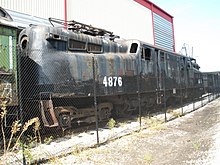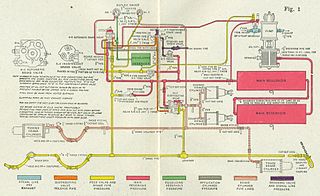
A railway air brake is a railway brake power braking system with compressed air as the operating medium. Modern trains rely upon a fail-safe air brake system that is based upon a design patented by George Westinghouse on April 13, 1869. The Westinghouse Air Brake Company was subsequently organized to manufacture and sell Westinghouse's invention. In various forms, it has been nearly universally adopted.

Washington Union Station, known locally as Union Station, is a major train station, transportation hub, and leisure destination in Washington, D.C. Designed by Daniel Burnham and opened in 1907, it is Amtrak's headquarters, the railroad's second-busiest station, and North America's 10th-busiest railroad station. The station is the southern terminus of the Northeast Corridor, an electrified rail line extending north through major cities including Baltimore, Philadelphia, New York City, and Boston, and the busiest passenger rail line in the nation. In 2015, it served just under five million passengers.
Rail transport terms are a form of technical terminology applied to railways. Although many terms are uniform across different nations and companies, they are by no means universal, with differences often originating from parallel development of rail transport systems in different parts of the world, and in the national origins of the engineers and managers who built the inaugural rail infrastructure. An example is the term railroad, used in North America, and railway, generally used in English-speaking countries outside North America and by the International Union of Railways. In English-speaking countries outside the United Kingdom, a mixture of US and UK terms may exist.
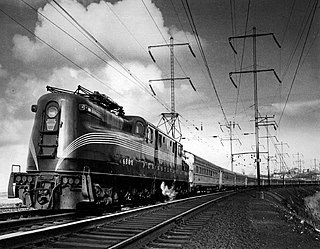
The Pennsylvania Railroad GG1 is a class of streamlined electric locomotives built for the Pennsylvania Railroad (PRR), in the northeastern United States. The class was known for its striking art deco shell, its ability to pull trains at up to 100 mph, and its long operating career of almost 50 years.
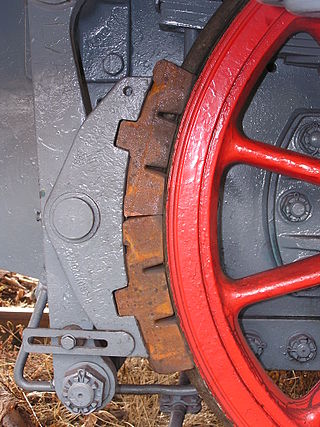
A railway brake is a type of brake used on the cars of railway trains to enable deceleration, control acceleration (downhill) or to keep them immobile when parked. While the basic principle is similar to that on road vehicle usage, operational features are more complex because of the need to control multiple linked carriages and to be effective on vehicles left without a prime mover. Clasp brakes are one type of brakes historically used on trains.
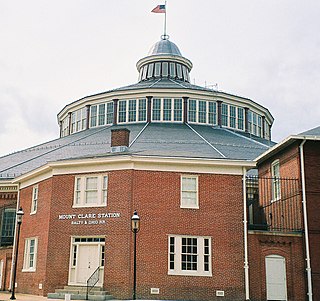
The B&O Railroad Museum is a museum and historic railway station exhibiting historic railroad equipment in Baltimore, Maryland. The Baltimore and Ohio Railroad (B&O) company originally opened the museum on July 4, 1953, with the name of the Baltimore & Ohio Transportation Museum. It has been called one of the most significant collections of railroad treasures in the world and has the largest collection of 19th-century locomotives in the U.S. The museum is located in the Baltimore and Ohio Railroad's old Mount Clare Station and adjacent roundhouse, and retains 40 acres of the B&O's sprawling Mount Clare Shops site, which is where, in 1829, the B&O began America's first railroad and is the oldest railroad manufacturing complex in the United States.

The Hammond Circus Train Wreck occurred on June 22, 1918, and was one of the worst train wrecks in U.S. history. Eighty-six people were reported to have died and another 127 were injured when a locomotive engineer fell asleep and ran his troop train into the rear of a circus train near Hammond, Indiana. The circus train held 400 performers and roustabouts of the Hagenbeck–Wallace Circus.
The Federal Express was an overnight named passenger train run by the Pennsylvania Railroad and the New York, New Haven and Hartford Railroad between Washington, DC's Union Station and Boston, Massachusetts's South Station from 1912 to 1971. At different times, its route has taken it across the Hudson River via a car float between Port Morris and Jersey City, the Poughkeepsie Bridge, and finally the Pennsylvania Tunnel and Terminal Railroad. The final routing was identical to today's high-speed Northeast Corridor.

On January 4, 1987, two trains collided on Amtrak's Northeast Corridor main line near Chase, Maryland, United States, at Gunpow Interlocking. Amtrak train 94, the Colonial, traveling north from Washington, D.C., to Boston, crashed at over 100 miles per hour (160 km/h) into a set of Conrail locomotives running light which had fouled the mainline. Fourteen passengers on the Amtrak train died, as well as the Amtrak engineer and lounge car attendant.

The San Bernardino train disaster, was a combination of two separate but related incidents that occurred in San Bernardino, California, United States: a runaway train derailment on May 12, 1989; and the subsequent failure on May 25, 1989, of the Calnev Pipeline, a petroleum pipeline adjacent to the tracks which was damaged by earth-moving equipment during the crash cleanup.
A runaway train is a type of railroad incident in which unattended rolling stock is accidentally allowed to roll onto the main line, a moving train loses enough braking power to be unable to stop in safety, or a train operates at unsafe speeds due to loss of operator control. If the uncontrolled rolling stock derails or hits another train, it will result in a train wreck.

Pennsylvania Railroad 4876 was a GG1-class electric locomotive built in January 1939 at the PRR's Altoona Works in Altoona, Pennsylvania, United States. It is best known for being involved in an accident on January 15, 1953, when the locomotive overran a buffer stop, crashed into the concourse of Union Station in Washington, D.C., and fell partway into the basement after the train's brakes failed. Due to the major crowds expected for the upcoming inauguration of Dwight D. Eisenhower, 4876 was lowered the rest of the way into the basement and a temporary floor was erected overhead. After the inauguration, the locomotive's frame and superstructure was essentially scrapped on site, with all the reusable components shipped back to Altoona, Pennsylvania, to reconstruct a replacement 4876, which operated for another 30 years.
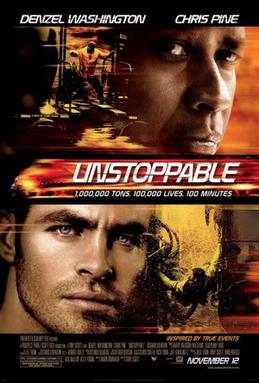
Unstoppable is a 2010 American disaster action thriller film directed and produced by Tony Scott, written by Mark Bomback, and starring Denzel Washington and Chris Pine. It is based on the real-life CSX 8888 incident, telling the story of a runaway freight train and the two men who attempt to stop it. It was the last film Scott directed before his death in 2012.
The 1906 Washington, D.C. train wreck occurred on the Metropolitan Branch of the Baltimore and Ohio Railroad (B&O) at Terra Cotta station in Washington, D.C., on December 30, 1906, at 6:31 in the evening, when a locomotive pulling six empty cars crashed into the back of a passenger train in dense fog, killing 53 people and injuring more than 70.
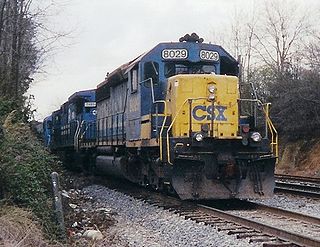
The CSX 8888 incident, also known as the Crazy Eights incident, was a runaway train event involving a CSX Transportation freight train in the U.S. state of Ohio on May 15, 2001. Locomotive #8888, an EMD SD40-2, was pulling a train of 47 cars, including some loaded with hazardous chemicals, and ran uncontrolled for just under two hours at up to 51 miles per hour (82 km/h). It was finally halted by a railroad crew in a second locomotive, which caught up with the runaway train and coupled their locomotive to the rear car.
An accident occurred on the four-track mainline of the New York Central Railroad at 10:02 P.M. on March 27, 1953, 2.4 miles east of Conneaut, Ohio. It began when an improperly secured load of pipe broke loose from a gondola car on an eastbound freight train, damaging the westbound passenger track. A passing westbound freight crew notified the first train and stopped to assess what had happened, but a fast westbound passenger train could not stop and was derailed by the damaged track, colliding with the adjacent westbound freight. Finally, an eastbound fast passenger train struck the derailed equipment from the first two trains. There were 21 deaths and 49 people were injured. This accident holds the record for the most trains involved in a single accident.

